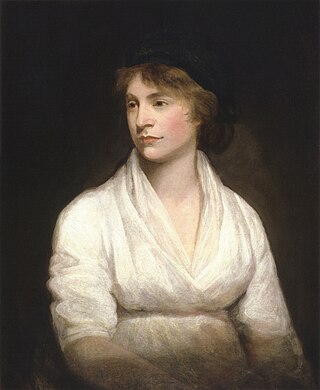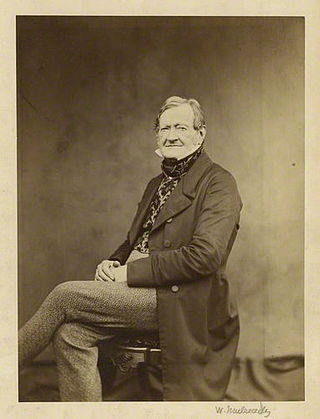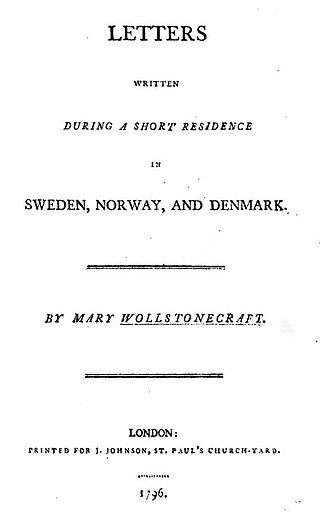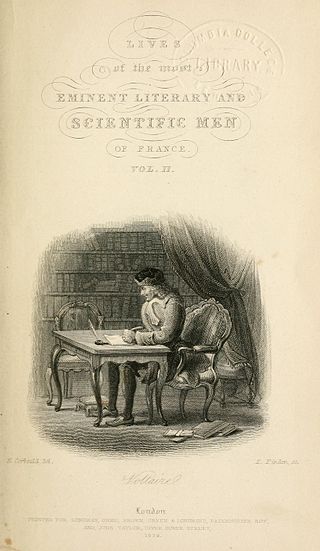Structure and plot
Mounseer Nongtongpaw is based on a popular 1796 song of the same name by the entertainer Charles Dibdin. [5] Dibdin's original song mocks English and French stereotypes in five eight-line stanzas, particularly "John Bull's" refusal to learn French. John Bull makes numerous inquiries to which he always receives the same response: "Monsieur, je vous n'entends pas" ("Monsieur, I don't understand you"), which he mistakenly interprets as "Mounseer Nongtongpaw". He comes to believe that the Palais Royal, Versailles, and a beautiful woman—the sights he sees while touring France—belong to this mysterious personage. When he comes upon a funeral and receives the same response, he concludes that all of Nongtongpaw's wealth could not save him from death. [1] Mounseer Nongtongpaw expands Dibdin's comic verses, adding more events to the narrative in shorter four-line stanzas, such as inquiries about a tavern feast, a shepherd's flock, a coach and four, and a hot-air balloon: [6]
[John Bull] ask'd who gave so fine a feast,
As fine as e'er he saw;
The landlord, shrugging at his guest,
Said "Je vous n'entends pas."
"Oh! MOUNSEER NONGTONGPAW!" said he:
"Well, he's a wealthy man,
"And seems dispos'd, from all I see,
"To do what good he can.
"A table set in such a style
"Holds forth a welcome sign," —
And added with an eager smile,
"With NONGTONGPAW I'll dine." [7]
Attribution
Mounseer Nongtongpaw was first attributed to the ten-and-a-half-year-old Mary Godwin (later Mary Shelley) in A Nursery Companion (1980) by Peter and Iona Opie. Don Locke supported this view in his biography of William Godwin, Mary's father, that same year. [8] The attribution rested on a 1960 advertisement by a book dealer, which printed part of a 2 January 1808 letter from William Godwin to an unknown correspondent: [9]
I therefore enclose two scribbles with which I would not otherwise have troubled you....That in small writing is the production of my daughter in her eleventh year, and is strictly modelled, as far as her infant talent would allow, on Dibdin's song....The whole object is to keep up the joke of Nong Tong Paw being constantly taken for the greatest man in France. [10]
"Dibdin's song" refers to the popular song by Charles Dibdin on which the poem is based. [5] The Opies wrote that "the presumption must be that the verses Godwin printed were those by his daughter". [11] In the 1831 introduction to Frankenstein , Shelley described her early childhood writing as that of "a close imitator—rather doing what others had done, than putting down the suggestions of my own mind". [12]
However, after the rediscovery of the entire letter, doubts emerged regarding this attribution:
Dear Sir,
In the midst of our short conversation of yesterday, & still more pleasant than short, you expressed a wish to receive a sketch in prose of the thing we desired. I am sure your kindness renders it a duty incumbent on me in return, to afford you every facility in my power. I therefore inclose two scribbles with which I would not otherwise have troubled you. That in small writing is the production of my daughter in her eleventh year, & is strictly modelled, as ar as [ sic ] her infant talents would allow, on Dibdin's song. This may answer the purpose of a prose sketch. The other is written by a young man of twenty. It is rather unintelligible: but the two first two stanzas may afford you a hint respecting the first two designs.
The more what you shall favour us with shall purely be your own, the more exquisite I am well satisfied it will be found. The whole object is to keep up the joke of Nong Tong Paw being constantly taken for the greatest man in France.
Believe me, with a thousand thanks,
My dear sir,
Very sincerely yours
W Godwin
Jan. 2, 1808.
May we send to you at ten or eleven to-morrow morning?
If you should have any thing to communicate, & should address it to Mr. Hooley, 41, Skinner Street, Snow Hill, it will reach me in safety. [13]
The complete letter suggests that the "small writing" was a prose piece, although Sunstein, the former owner of the letter (which is now held by The Carl H. Pforzheimer Collection of Shelley and His Circle), argues that the wording is open to interpretation. [14] She claims that "read in its entirely, [the letter] indicates that Mary Godwin wrote the initial revised text for Nongtongpaw, but not the final version". [15] She argues "that Mary Godwin's revision was usable for a 'prose sketch' does not necessarily mean that she wrote it in prose". [16]
According to Jeanne Moskal, one of the editors of the most recent definitive edition of Mary Shelley's works, "It can be deduced from the letter, and corroborated by other circumstantial evidence uncovered by Sunstein, that the correspondent had been invited to write a new version of Dibdin's song and that the correspondent and the composer of the 1808 text were therefore one and the same." [17]

Mary Wollstonecraft was a British writer, philosopher, and advocate of women's rights. Until the late 20th century, Wollstonecraft's life, which encompassed several unconventional personal relationships at the time, received more attention than her writing. Today Wollstonecraft is regarded as one of the founding feminist philosophers, and feminists often cite both her life and her works as important influences.

The figure of Mother Goose is the imaginary author of a collection of French fairy tales and later of English nursery rhymes. As a character, she appeared in a song, the first stanza of which often functions now as a nursery rhyme. This, however, was dependent on a Christmas pantomime, a successor to which is still performed in the United Kingdom.

William Godwin was an English journalist, political philosopher and novelist. He is considered one of the first exponents of utilitarianism and the first modern proponent of anarchism. Godwin is most famous for two books that he published within the space of a year: An Enquiry Concerning Political Justice, an attack on political institutions, and Things as They Are; or, The Adventures of Caleb Williams, an early mystery novel which attacks aristocratic privilege. Based on the success of both, Godwin featured prominently in the radical circles of London in the 1790s. He wrote prolifically in the genres of novels, history and demography throughout his life.

Amelia Opie was an English author who published numerous novels in the Romantic period up to 1828. Opie was also a leading abolitionist in Norwich, England. Hers was the first of 187,000 names presented to the British Parliament on a petition from women to stop slavery.

Clara Mary Jane Clairmont, or Claire Clairmont as she was commonly known, was the stepsister of the writer Mary Shelley and the mother of Lord Byron's daughter Allegra. She is thought to be the subject of a poem by Percy Bysshe Shelley.

William Mulready was an Irish genre painter living in London. He is best known for his romanticising depictions of rural scenes, and for creating Mulready stationery letter sheets, issued at the same time as the Penny Black postage stamp.

A Vindication of the Rights of Men, in a Letter to the Right Honourable Edmund Burke; Occasioned by His Reflections on the Revolution in France (1790) is a political pamphlet, written by the 18th-century British writer and women's rights advocate Mary Wollstonecraft, which attacks aristocracy and advocates republicanism. Wollstonecraft's was the first response in a pamphlet war sparked by the publication of Edmund Burke's Reflections on the Revolution in France (1790), a defense of constitutional monarchy, aristocracy, and the Church of England.

Proserpine is a verse drama written for children by the English Romantic writers Mary Shelley and her husband Percy Bysshe Shelley. Mary wrote the blank verse drama and Percy contributed two lyric poems. Composed in 1820 while the Shelleys were living in Italy, it is often considered a partner to the Shelleys' play Midas. Proserpine was first published in the London periodical The Winter's Wreath in 1832. Whether the drama was ever intended to be staged is a point of debate among scholars.

Valperga: or, the Life and Adventures of Castruccio, Prince of Lucca is an 1823 historical novel by the Romantic novelist Mary Shelley, set amongst the wars of the Guelphs and Ghibellines.
Frances Imlay, also known as Fanny Godwin and Frances Wollstonecraft, was the illegitimate daughter of the British feminist Mary Wollstonecraft and the American commercial speculator and diplomat Gilbert Imlay. Wollstonecraft wrote about her frequently in her later works. Fanny grew up in the household of anarchist political philosopher William Godwin, the widower of her mother, with his second wife Mary Jane Clairmont and their combined family of five children. Fanny's half-sister Mary grew up to write Frankenstein and married Percy Bysshe Shelley, a leading Romantic poet, who composed a poem on Fanny's death.

Letters Written During a Short Residence in Sweden, Norway, and Denmark (1796) is a personal travel narrative by the eighteenth-century British feminist writer Mary Wollstonecraft. The twenty-five letters cover a wide range of topics, from sociological reflections on Scandinavia and its peoples to philosophical questions regarding identity. Published by Wollstonecraft's career-long publisher, Joseph Johnson, it was the last work issued during her lifetime.

Mont Blanc: Lines Written in the Vale of Chamouni is an ode by the Romantic poet Percy Bysshe Shelley. The poem was composed between 22 July and 29 August 1816 during Shelley's journey to the Chamonix Valley, and intended to reflect the scenery through which he travelled. "Mont Blanc" was first published in 1817 in Percy Shelley and Mary Shelley's History of a Six Weeks' Tour through a Part of France, Switzerland, Germany and Holland, which some scholars believe to use "Mont Blanc" as its culmination.

The Lives of the Most Eminent Literary and Scientific Men comprised ten volumes of Dionysius Lardner's 133-volume Cabinet Cyclopaedia (1829–1846). Aimed at the self-educating middle class, this encyclopedia was written during the 19th-century literary revolution in Britain that encouraged more people to read.

Midas is a verse drama in blank verse by the Romantic writers Mary Shelley and Percy Bysshe Shelley. Mary wrote the drama and Percy contributed two lyric poems to it. Written in 1820 while the Shelleys were living in Italy, Mary Shelley tried unsuccessfully to have the play published by children's magazines in England in the 1830s; however, it was not published until A. Koszul's 1922 scholarly edition. Whether or not the drama was ever meant to be staged is a point of debate among scholars. The play combines the stories of the musical contest between Apollo and Pan and that of King Midas and his ability to turn everything he touches to gold.

Frankenstein; or, The Modern Prometheus is an 1818 novel written by English author Mary Shelley. Frankenstein tells the story of Victor Frankenstein, a young scientist who creates a sapient creature in an unorthodox scientific experiment. Shelley started writing the story when she was 18, and the first edition was published anonymously in London on 1 January 1818, when she was 20. Her name first appeared in the second edition, which was published in Paris in 1821.

History of a Six Weeks' Tour through a part of France, Switzerland, Germany, and Holland; with Letters Descriptive of a Sail Round the Lake of Geneva and of the Glaciers of Chamouni is a travel narrative by the English Romantic authors Mary Shelley and Percy Bysshe Shelley. Published anonymously in 1817, it describes two trips taken by Mary, Percy, and Mary's stepsister, Claire Clairmont: one across Europe in 1814, and one to Lake Geneva in 1816. Divided into three sections, the text consists of a journal, four letters, and Percy Shelley's poem "Mont Blanc". Apart from the poem, preface, and two letters, the text was primarily written and organised by Mary Shelley. In 1840 she revised the journal and the letters, republishing them in a collection of Percy Shelley's writings.

Percy Bysshe Shelley was one of the major English Romantic poets. A radical in his poetry as well as in his political and social views, Shelley did not achieve fame during his lifetime, but recognition of his achievements in poetry grew steadily following his death and he became an important influence on subsequent generations of poets including Robert Browning, Algernon Charles Swinburne, Thomas Hardy, and W. B. Yeats. American literary critic Harold Bloom describes him as "a superb craftsman, a lyric poet without rival, and surely one of the most advanced sceptical intellects ever to write a poem."

Rambles in Germany and Italy, in 1840, 1842, and 1843 is a travel narrative by the British Romantic author Mary Shelley. Issued in 1844, it is her last published work. Published in two volumes, the text describes two European trips that Mary Shelley took with her son, Percy Florence Shelley, and several of his university friends. Mary Shelley had lived in Italy with her husband, Percy Bysshe Shelley, between 1818 and 1823. For her, Italy was associated with both joy and grief: she had written much while there but she had also lost her husband and two of her children. Thus, although she was anxious to return, the trip was tinged with sorrow. Shelley describes her journey as a pilgrimage, which will help cure her depression.

"Fragment of a Novel" is an unfinished 1819 vampire horror story written by Lord Byron. The story, also known as "A Fragment" and "The Burial: A Fragment", was one of the first in English to feature a vampire theme. The main character was Augustus Darvell. John William Polidori based his novella The Vampyre (1819), originally attributed in print to Lord Byron, on the Byron fragment. The vampire in the Polidori story, Lord Ruthven, was modelled on Byron himself. The story was the result of the meeting that Byron had in the summer of 1816 with Percy Bysshe Shelley where a "ghost writing" contest was proposed. This contest was also what led to the creation of Frankenstein according to Percy Bysshe Shelley's 1818 Preface to the novel. The story is important in the development and evolution of the vampire story in English literature as one of the first to feature the modern vampire as able to function in society in disguise. The short story first appeared under the title "A Fragment" in the 1819 collection Mazeppa: A Poem, published by John Murray in London.

Mary Wollstonecraft Shelley was an English novelist who wrote the Gothic novel Frankenstein; or, The Modern Prometheus (1818), which is considered an early example of science fiction and one of her best-known works. She also edited and promoted the works of her husband, the Romantic poet and philosopher Percy Bysshe Shelley. Her father was the political philosopher William Godwin and her mother was the philosopher and women's rights advocate Mary Wollstonecraft.





















